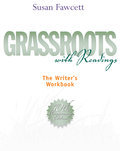
Using her unique M-A-P approach (Model-Analysis-Practice), Susan Fawcett's books have guided hundreds of thousands of students through the writing process,from foundations of grammar, mechanics, and spelling, through writing clear sentences and well-organized paragraphs. Her inductive approach; plentiful, high-interest student models and practices; and contemporary readings engage and motivate students. This edition of GRASSROOTS features improved grammar coverage and emphasizes proofreading, with a new Chapter 6 that teaches specific proofreading strategies and shows students how to recognize their personal "error patterns," track, and correct them. Every subsequent chapter offers a proofing strategy for the concept being taught. Full-color illustrations, including 45 photos, cartoons, and artworks, plus a new design, help students visualize and understand key concepts. INDICE: Preface. UNIT 1: WRITING EFFECTIVE PARAGRAPHS. Each chapter in Unit 1 includes end-of-chapter features Chapter Highlights and Exploring Online. 1. Exploring the Writing Process. A. The Writing Process. B. Subject, Audience, and Purpose. C. Guidelines for Submitting Written Work. 2. Prewriting to Generate Ideas. A. Freewriting. B. Brainstorming. C. Clustering. D. Keeping a Journal. 3. Developing Effective Paragraphs. A. Defining the Paragraph and the Topic Sentence. B. Narrowing the Topic and Writing the Topic Sentence. C. Generating Ideas for the Body of the Paragraph. D. Selecting and Dropping Ideas. E. Arranging Ideas in a Plan or an Outline. F. Writing and Revising the Paragraph. G. Writing the Final Draft. 4. Improving Your Paragraphs. A. More Work on Support: Examples. B. More Work on Arranging Ideas: Coherence. C. More Work on Revising: Exact and Concise Language. D. Turning Assignments into Paragraphs. 5. Moving from Paragraph to Essay. A. Defining the Essay and the Thesis Statement. B. The Process of Writing an Essay. 6. Proofreading to Correct Your Personal Errors. A. Identifying and Tracking Your Personal Error Patterns. B. Proofreading Strategies. Unit 1. Writing Assignments. Unit 1. Review. Unit 1. Writers' Workshop: Discuss Your Name. UNIT 2: WRITING COMPLETE SENTENCES. Each chapter in Unit 2 includes end-of-chapter features Chapter Highlights, ProofreadingStrategy, Writing and Proofreading Assignments, Chapter Review, and ExploringOnline. 7. Subjects and Verbs. A. Defining and Spotting Subjects. B. SpottingSingular and Plural Subjects. C. Spotting Prepositional Phrases. D. Defining and Spotting Action Verbs. E. Defining and Spotting Linking Verbs. F. SpottingVerbs of More Than One Word. 8. Avoiding Sentence Fragments. A. Writing Sentences with Subjects and Verbs. B. Writing Sentences with Complete Verbs. C. Completing the Thought. Unit 2. Writing Assignments. Unit 2. Review. Unit 2. Writers' Workshop: Discuss an Event That Influenced You. UNIT 3: USING VERBS EFFECTIVELY. Each chapter in Unit 3 includes end-of-chapter features Chapter Highlights, Proofreading Strategy, Writing and Proofreading Assignments, Chapter Review, and Exploring Online 9. Present Tense (Agreement). A. Defining Agreement.B. Troublesome Verb in the Present Tense: TO BE. C. Troublesome Verb in the Present Tense: TO HAVE. D. Troublesome Verb in the Present Tense: TO DO (+ NOT). E. Changing Subjects to Pronouns. F. Practice in Agreement. G. Special Problems in Agreement. 10. Past Tense. A. Regular Verbs in the Past Tense. B. Irregular Verbs in the Past Tense. C. Troublesome Verb in the Past Tense: TO BE. D.Review. 11. The Past Participle in Action. A. Defining the Past Participle. B. Past Participles of Regular Verbs. C. Past Participles of Irregular Verbs. D. Using the Present Perfect Tense. E. Using the Past Perfect Tense. F. Using the Passive Voice. G. Using Past Participles as Adjectives. 12. Progressive Tenses (TO BE + -ING Verb Form). A. Defining and Writing the Present Progressive Tense. B. Defining and Writing the Past Progressive Tense. C. Using the Progressive Tenses. D. Avoiding Incomplete Progressives. 13. Fixed-Form Helping Verbs and Verb Problems. A. Defining and Spotting the Fixed-Form Helping Verbs. B.Using the Fixed-Form Helping Verbs. C. Using CAN and COULD. D. Using WILL andWOULD. E. Writing Infinitives. F. Revising Double Negatives. Unit 3. Writing Assignments. Unit 3. Review. Unit 3. Writers' Workshop: Tell a Family Story. UNIT 4: JOINING IDEAS TOGETHER. Each chapter in Unit 4 includes end-of-chapter features Chapter Highlights, Proofreading Strategy, Writing and Proofreading Assignments, Chapter Review, and Exploring Online 14. Coordination. 15. Subordination. A. Defining and Using Subordinating Conjunctions. B. Punctuating Subordinating Conjunctions. 16. Avoiding Run-Ons and Comma Splices. 17. Semicolons and Conjunctive Adverbs. A. Defining and Using Semicolons. B. Defining and Using Conjunctive Adverbs. C. Punctuating Conjunctive Adverbs. 18. Relative Pronouns. A. Defining and Using Relative Pronouns. B. Punctuating Ideas Introduced by WHO, WHICH, or THAT. 19. -ING Modifiers. A. Using -ING Modifiers. B. Avoiding Confusing Modifiers. Unit 4. Writing Assignments. Unit 4. Review. Unit 4. Writers' Workshop: Describe a Detour off the Main Highway. UNIT 5: CHOOSING THE RIGHT NOUN, PRONOUN, ADJECTIVE, ADVERB, OR PREPOSITION. Each chapter in Unit5 includes end-of-chapter features Chapter Highlights, Proofreading Strategy,Writing and Proofreading Assignments, Chapter Review, and Exploring Online 20. Nouns. A. Defining Singular and Plural. B. Signal Words: Singular and Plural. C. Signal Words with OF. 21. Pronouns. A. Defining Pronouns and Antecedents.B. Referring to Indefinite Pronouns. C. Referring to Collective Nouns. D. Referring to Special Singular Constructions. E. Avoiding Vague and Repetitious Pronouns. F. Using Pronouns as Subjects, Objects, and Possessives. G. Choosing the Correct Case After AND or OR. H. Choosing the Correct Case in Comparisons. I. Using Pronouns with -SELF and -SELVES. 22. Adjectives and Adverbs. A. Defining and Writing Adjectives and Adverbs. B. A Troublesome Pair: GOOD/WELL. C. Writing Comparatives. D. Writing Superlatives. E. Troublesome Comparatives andSuperlatives. F. Demonstrative Adjectives: THIS/THAT and THESE/THOSE. 23. Prepositions. A. Defining and Working with Prepositional Phrases. B. Troublesome Prepositions: IN, ON, and LIKE. C. Prepositions in Common Expressions. Unit 5.Writing Assignments. Unit 5. Review. Unit 5. Writers' Workshop: Tell How Someone Changed Your Life. UNIT 6: REVISING FOR CONSISTENCY AND PARALLELISM. Each chapter in Unit 6 includes end-of-chapter features Chapter Highlights, Proofreading Strategy, Writing and Proofreading Assignments, Chapter Review, and Exploring Online. 24. Consistent Tense. 25. Consistent Person. 26. Parallelism. A.Writing Parallel Constructions.
- ISBN: 978-0-495-90123-5
- Editorial: Heinle & Heinle
- Encuadernacion: Rústica
- Páginas: 512
- Fecha Publicación: 31/01/2011
- Nº Volúmenes: 1
- Idioma: Inglés
